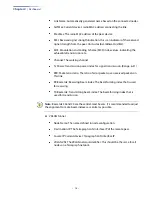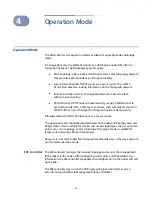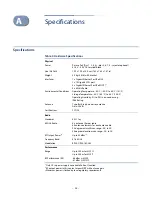
Chapter 4
| Operation Mode
Operation Mode
– 23 –
IPv6 addressing and
physical port
assignment on the
POP node
Figure 10: POP Configuration
A POP node acts as a router between the Terragraph network and the uplink
network (or backhaul network). The Terragraph network lives on the LAN side of
the POP node whereas the uplink network lives on its WAN side.
The WAN side is conceptually separated into two paths; the data path and the
control path.
The data path is for transferring data to and from the end users. The configuration
of this path requires the Terragraph WAN Address (VPP_ADDR) and the Gateway
Address to forward data to and from the uplink network.
The control path is for management traffic of DNs and CNs. The configuration
requires a Control Address so that the network can be accessed for management
purposes.
On the LAN side of the POP node, Open/R automatically assigns a /64 prefix to DN
and CN nodes when these are added to the Terragraph network. Configure the
Terragraph LAN Prefix and Terragraph LAN Prefix Length to guarantee the address
pool is large enough to accommodate all nodes.
There are six wired network interfaces on the MLTG-360. The MGMT port (PoE In) is
a dedicated, out-of-band management port, isolated from other ports.
From the remaining five ports (LAN1 to LAN4, and SFP+), one must be assigned to
the control path at the WAN side (Control Interface or POP_ADDR). To configure it
as a dedicated port, set Control VLAN to 0.
Setting the Control VLAN to a different numeric value means the control interface is
only accessible for management purposes using the specific VLAN ID tag. The port
is still available as data path for untagged traffic and traffic with different VLAN IDs.
The other four ports are bridged together and forward traffic to the data path in a
Layer 2 manner.















































